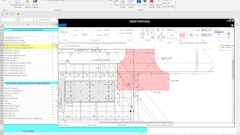
The Challenge:
Cap a 28-acre landfill by evenly grading the entire site and providing a cover impermeable to the elements to prevent runoff from migrating through the refuse, getting contaminated and reaching the groundwater
The Players:
New York State Department of Environmental Conservation
Islip Resource Recovery Agency
Cashin Associates, P.C.
Adam’s European Contracting
Mesh Consulting
The Process:
Capping the 28-acre Lincoln Avenue Landfill in Holbrook, N.Y., in adherence to current environmental regulations was on the New York State Department of Environmental Conservation’s (NYSDEC) to-do list since 1986. Back then, the Town of Islip and the Islip Resource Recovery Agency (IRRA) entered into an Order of Consent with NYSDEC to develop a final closure plan for the landfill. As of 2012, the estimated cost was $16 million, including about $10 million for closure and capping, and the remainder for post-closure maintenance and monitoring for 30 years.
Scheduled for completion in November 2012, the objective of the capping project is to evenly grade the entire site and then provide a cover that is as impermeable to the elements as possible to prevent runoff from migrating through the refuse, getting contaminated and reaching the groundwater. The site will also have a Greenfield appearance and resemble a landfill as little as possible. “When you put a cap over it, it’s kind of like putting an umbrella over it so that when it rains, the water doesn't go through it and into the ground,” said Robert Doutney, resident engineer/construction manager for Cashin Associates, P.C. of Hauppage, N.Y., hired by IRRA to provide environmental engineering services.
Cleaning the dump
Detailed record keeping of refuse dumping at landfills, as well as the implementation of recycling practices, emerged long after the Lincoln Avenue Landfill was active. For decades, many refuse items - now commonly separated from the waste stream and recycled - were commingled and dumped at the site. Refuse such as broken concrete pavement, which today is crushed into recycled aggregate, was dumped in various locations and had to be excavated for fill elsewhere on the site.
For the company awarded the capping contract, Adam’s European Contracting, Brooklyn, N.Y., the haphazard dumping pattern made for a laborious process of moving about 300,000 cubic yards of material in grading the landfill according to the final closure plan.
This was a new type of work for Adam’s European. “We’ve got the equipment, so we bid the job - it is basically an earthmoving job,” said Jacek Skarzynski, director of operations.
Additional blade control dimension on steep slopes
In mid-January 2012, Adam’s European began its work, starting with clearing and grubbing - i.e., tearing out tree roots - for almost a month. By March, grading was well underway. In one spot, an excavator dug out chunks of broken concrete and placed them into a procession of dump trucks. Nearby, a Komatsu D61PX-15 equipped with a Topcon Positioning Systems' 3D-MC2 automatic grade control system pushed dirt uphill and stakelessly graded a large area. Don Horsfield operated the D61PX-15. On the other side of the site, Gary Spotswood used a Komatsu D65PX-17, also equipped with a 3D-MC2 system, to grade a 3:1 slope.
Twin antennas mounted on a pole in the middle of the blade of Horsfield’s dozer provided Adam’s European with a key technological - and ultimately financial - boost on this project. Use of the twin antenna maintains the efficiency of the 3D-MC2 system on cross-slopes, according to Jim Cleary of Adam’s European’s Topcon dealer, Cleary Machinery. Use of the twin-antenna 3D-MC2 system provides control of a dozer blade in an additional dimension versus a single antenna.
In addition to controlling the raising and lowering of the blade, the system measures blade angling, which provides more accurate grades when the blade is angled.
No stakes required
Once the site was graded to specifications, Adam’s European put down a geocomposite gas venting layer, which allows the methane gas trapped beneath the surface to transmit to the gas vents. Next, the contractor installed a polyethylene geomembrane liner that would waterproof the gas venting layer and allow drainage without erosion. Another layer consisting of drainage geocomposite that acts like a flat pipe to collect water from the top of the polyethylene geomembrane liner and direct it to the new drainage system was also be installed. A 1.5-foot layer of silty soil, was to be placed on top of the drainage geocomposite followed by a 6-inch layer of topsoil to be used on top of the cap. This top layer will be hydroseeded to prevent erosion.
In addition, Adam’s European was contracted to cut some areas of the landfill and use the material as fill elsewhere in the process of reshaping the site to the specified grades. However, it was not a typical excavation project in which dozer operators make long passes and keep their machines moving almost constantly. The process was more painstaking for two reasons.
- Trash compacts more but is less homogeneous than most types of dirt.
- The landfill contains many tons of broken concrete. That material cannot be pushed with a dozer but must be picked out piece by piece with excavators and moved to fill areas with dump trucks.
There was nothing that Adam’s European could do about the relatively slow process of moving material around the site, but its use of the 3D-MC2 system allowed the company to recoup significant efficiency in terms of staking - or the lack thereof.
Mesh Consulting, Limerick, Penn., had built a two-dimensional CAD file from the official survey and a second file indicating the trash in the landfill. For both files, Mesh converted the lines in the digital file into three-dimensional lines and then added contour lines. Mesh then converted the files from CAD to Topcon-3D Office, saving linework as an LN.3 file and the 3-D surface as a TN.3 file. The files were then loaded into the 3D-MC2 systems in Adam’s European’s two dozers. By using two separate files for finished grade and trash, the contractor eliminated the need to drive stakes in the ground.
Don Talend, Write Results Inc., West Dundee, Ill., is a print and e-communications content developer specializing in covering construction, technology and innovation.






























